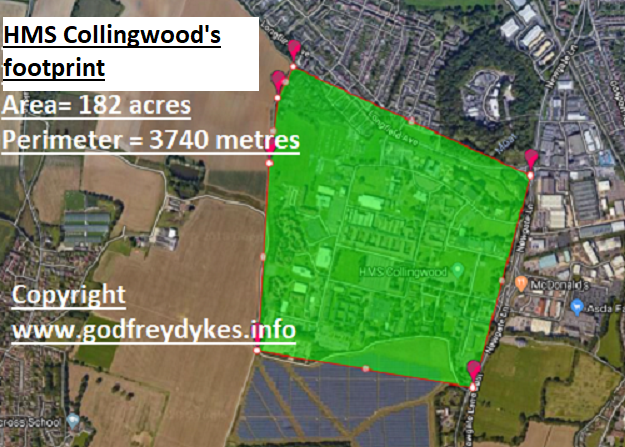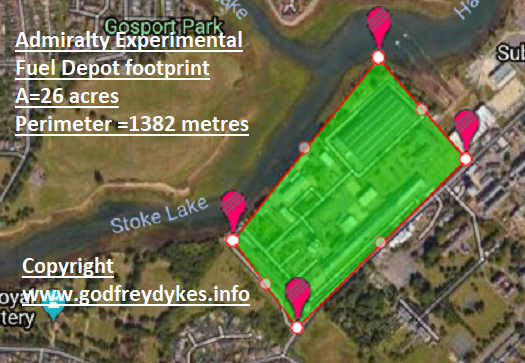


Who has the most individual Naval Establishments
Portsmouth or Gosport?Written by Godfrey Dykes© RN Communications Branch Museum/Library
<
A History with a difference but none the less a History
Gosport had for a long time, been the poor cousin of the Portsmouth Command so said some, but in reality, it had punched more than its weight over the years. The years to which I allude have sadly gone now and both sides of the harbour have suffered because of severe cuts to defence budgets, year on year, governments on governments.
As should be obvious from my title above when I have used the word 'had', that what follows is a reflection on the past, a past which saw Gosport and Fareham naval establishments as leaders in the provision of naval support, operational and administrative, far far removed from being (at any time) the lame-duck of the premier naval port of Portsmouth. The port and the harbour should of course be referred to as the Portsmouth and Gosport harbour and port, but it never was, and as sure as eggs are eggs, it never will be now!
The page is intended to be a "history of the 'support navy" of the Portsmouth Command, functioning to keep our ships, submarines and fleet air arm squadrons at sea, seen from an usual perspective, namely the Admiralty's and then from 1964 onwards, the MOD(N)'s portfolio of real estate, measured in the traditional way of acres or hectares, all intended, whether small plots or large, to make sure the seagoing navy had everything possible to sustain it in battle, albeit, subservient (of course) to the wonderful and essential services provided by the ubiquitous dockyard personnel, but who, once the ship's were again seaworthy, took a back seat to become subservient to the wonderful and essential services provided by the support services. Crews without victuals (and rum?) - guns without shells - engines without fuel were just as useless to the fleet as were crippled or defect hulls! This rather perverse way of delineating the size of a fleet support service differs hugely from the traditional use of 'long tons' used to describe the displacement of our seagoing vessels! However, in this case, a large acreage equates to a large displacement, both pointing to something big and important?
The following list is not a list one should refer to with dogma, especially when comparing Gosport with Portsmouth in terms of overall size, for the support Portsmouth footprint is not as large as many think whereas the Gosport/Fareham footprint is much larger by far and transcends that of its cross-the-harbour neighbour.
So, just as an exercise of nostalgia, here are the establishment which jointly made up the Portsmouth Command under the overall command of the C-in-C Portsmouth, some still extant.
Please note! Not all my maps have been made using the same zooming level, but irrespective of the sizes of pictures shown, the acreages are correct.
© RN Communications Branch Museum/Library
<A History with a difference but none the less a History
Gosport had for a long time, been the poor cousin of the Portsmouth Command so said some, but in reality, it had punched more than its weight over the years. The years to which I allude have sadly gone now and both sides of the harbour have suffered because of severe cuts to defence budgets, year on year, governments on governments.
As should be obvious from my title above when I have used the word 'had', that what follows is a reflection on the past, a past which saw Gosport and Fareham naval establishments as leaders in the provision of naval support, operational and administrative, far far removed from being (at any time) the lame-duck of the premier naval port of Portsmouth. The port and the harbour should of course be referred to as the Portsmouth and Gosport harbour and port, but it never was, and as sure as eggs are eggs, it never will be now!
The page is intended to be a "history of the 'support navy" of the Portsmouth Command, functioning to keep our ships, submarines and fleet air arm squadrons at sea, seen from an usual perspective, namely the Admiralty's and then from 1964 onwards, the MOD(N)'s portfolio of real estate, measured in the traditional way of acres or hectares, all intended, whether small plots or large, to make sure the seagoing navy had everything possible to sustain it in battle, albeit, subservient (of course) to the wonderful and essential services provided by the ubiquitous dockyard personnel, but who, once the ship's were again seaworthy, took a back seat to become subservient to the wonderful and essential services provided by the support services. Crews without victuals (and rum?) - guns without shells - engines without fuel were just as useless to the fleet as were crippled or defect hulls! This rather perverse way of delineating the size of a fleet support service differs hugely from the traditional use of 'long tons' used to describe the displacement of our seagoing vessels! However, in this case, a large acreage equates to a large displacement, both pointing to something big and important?
The following list is not a list one should refer to with dogma, especially when comparing Gosport with Portsmouth in terms of overall size, for the support Portsmouth footprint is not as large as many think whereas the Gosport/Fareham footprint is much larger by far and transcends that of its cross-the-harbour neighbour.
So, just as an exercise of nostalgia, here are the establishment which jointly made up the Portsmouth Command under the overall command of the C-in-C Portsmouth, some still extant.
Please note! Not all my maps have been made using the same zooming level, but irrespective of the sizes of pictures shown, the acreages are correct.
The page is intended to be a "history of the 'support navy" of the Portsmouth Command, functioning to keep our ships, submarines and fleet air arm squadrons at sea, seen from an usual perspective, namely the Admiralty's and then from 1964 onwards, the MOD(N)'s portfolio of real estate, measured in the traditional way of acres or hectares, all intended, whether small plots or large, to make sure the seagoing navy had everything possible to sustain it in battle, albeit, subservient (of course) to the wonderful and essential services provided by the ubiquitous dockyard personnel, but who, once the ship's were again seaworthy, took a back seat to become subservient to the wonderful and essential services provided by the support services. Crews without victuals (and rum?) - guns without shells - engines without fuel were just as useless to the fleet as were crippled or defect hulls! This rather perverse way of delineating the size of a fleet support service differs hugely from the traditional use of 'long tons' used to describe the displacement of our seagoing vessels! However, in this case, a large acreage equates to a large displacement, both pointing to something big and important?
The following list is not a list one should refer to with dogma, especially when comparing Gosport with Portsmouth in terms of overall size, for the support Portsmouth footprint is not as large as many think whereas the Gosport/Fareham footprint is much larger by far and transcends that of its cross-the-harbour neighbour.
So, just as an exercise of nostalgia, here are the establishment which jointly made up the Portsmouth Command under the overall command of the C-in-C Portsmouth, some still extant.
Please note! Not all my maps have been made using the same zooming level, but irrespective of the sizes of pictures shown, the acreages are correct.
| HM Dockyard | HMS Siskin *1 | ||
| Queen Street Barracks | HMS Sultan *1 | ||
| Pitt Street | HMS Dolphin | ||
| HMS Vernon | RNH Haslar | ||
| RM Barracks Eastney | Institute of Naval Medicine ? | ||
| Stamshaw | Gosport Naval Barracks | ||
| Victoria Barracks | RN Cemetery Clayhall | ||
| Duchess of Kent Barracks | HMS Ariel *2 | ||
| HMS Excellent | HMS Daedalus *2 | ||
| HMS Phoenix | RN Survival School Seafield Park | ||
| ASWE | Admiralty Fuel Experimental Establishment ? | ||
| Fort Southwick | Gilkicker Signal Station | ||
| HMS Temeraire | Torpedo Range and Jetty Stokes Bay | ||
| - | HMS Hornet | ||
| - | Clarence Victualling Yard | ||
| - | Forton Road Barracks | ||
| - | RNAD Frater | ||
| - | RNAD Priddys Hard/Bedenham | ||
| - | HMS Centurion | ||
| - | Rowner Ratings MQ's ? | ||
| - | RNAY Fleetlands | ||
| - | HMS Collingwood | ||
| 1* = Same establishment first named Siskin and then Sultan 2* = Same establishment first named Ariel and then Daedalus 1# = These two areas are considered as one called the Portsmouth Naval Base, and virtually seamless divided only by the dockyard wall and a gateway through it. Shown in Red -No longer in the MOD(N) Portfolio ? = Disposition not known | |||















